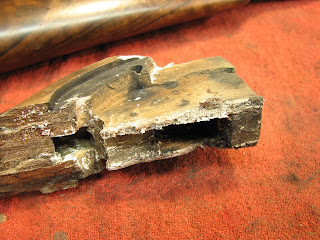What do those things have to do with the gun world, you ask? Well, the answer is simple: Like certain things in the gun world, they don't exist, yet people swear that they have seen them.
One common example of the gun world equivalent of a Bigfoot sighting is the "16 gauge built on a 20 gauge frame". Now, almost everyone who has ever spent any amount of time around doublegun guys of a certain age has heard someone brag about their gun that has the above-mentioned configuration, or some variant thereof, like a 20 on a 28 frame, etcetera. The thing is, there is no such thing. That's right, there is no such thing as a 12 on a 16 frame, a 16 on a 20 frame, a 20 on a 28 frame or an anything-else on an any-other frame.
This is because there is not now, nor has there ever been, an industry standard for frame sizes of any gauge, for any break-action gun. There have been manufacturers that have made use of different frame sizes for different gauges but in the case of American makers, usually there was one size. Often, the only difference between a 12 gauge and a smaller-bore frame was the bore-center spacing and the corresponding size of the fences, with the actual bar of the frame remaining the same size. These are not small frames because the entire frame was not scaled down proportionately for the smaller-gauge applications.
The standout exception to the above rule is the Fox gun. Fox made two frame sizes (not counting the Super): large and small. The large frames were all twelves, while the sixteens and twenties shared the same small frame, which was scaled down in all dimensions. Some owners of Fox sixteens will brag to all who will listen that their guns are really built on "20-gauge" frames, because a well-known gunwriter once wrote this entirely subjective opinion in his book on the Fox. If that's what they want to believe, more power to them but it doesn't make it true. It could just as easily, and no less accurately, be said that the Fox twenty is built on a sixteen gauge frame but no one will ever say that because it doesn't sound "cool". Where the Fox is concerned, there are twelves and small frames, period.
There were Parkers made in 12 gauge on their #1 frame. Does that make it a 12 on a 16 (or 20) frame? No, it makes it a 12 gauge on a #1 frame, in exactly the same way that a 12gauge Parker on a #3 frame isn't a 12 gauge on a 10 gauge frame. It's just a 12 on a #3 frame.
Where a manufacturer actually does make a frame that is specifically scaled to each caliber, things are still not definitive, because one maker's idea of a scaled frame may not be the same as another maker's, for the same caliber.
Some more "pulled-from-the-ass wisdom" is that if a shotgun's barrels don't actually meet at the muzzle, then they have definitively been cut. The rationale behind this is usually along the line of "the factory wouldn't let something like that go out the door". Yeah, OK, as if "the factory" were some temple of righteous perfection in craftsmanship. Those that subscribe to this line of thinking would literally not believe some of the examples of factory-original misalignment of barrels that I've seen on American doubles. Here's a of photo of something that, according to some, would never have left the factory. Unlike those grainy Loch Ness Monster photos, this is actually real.




















































































